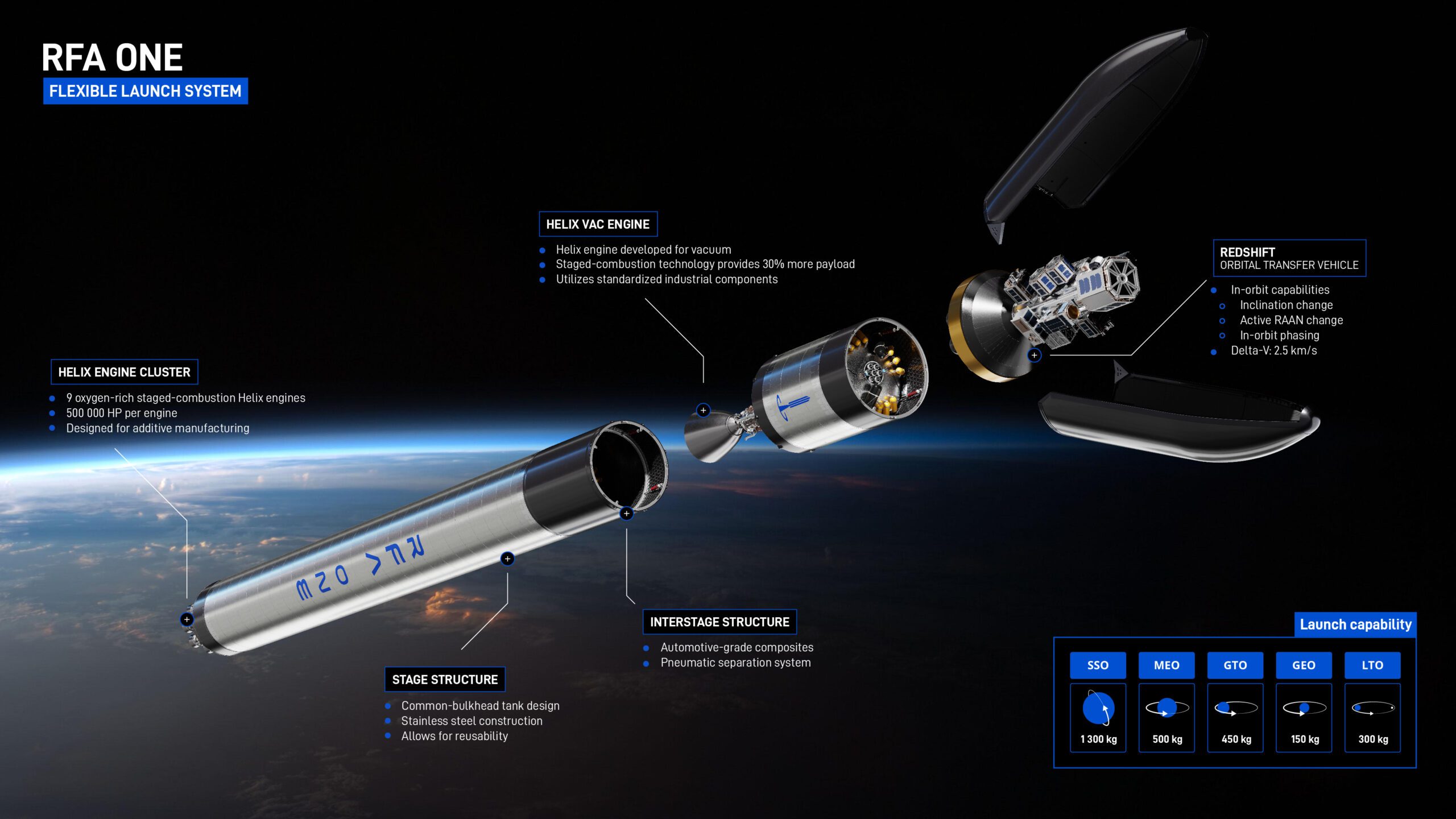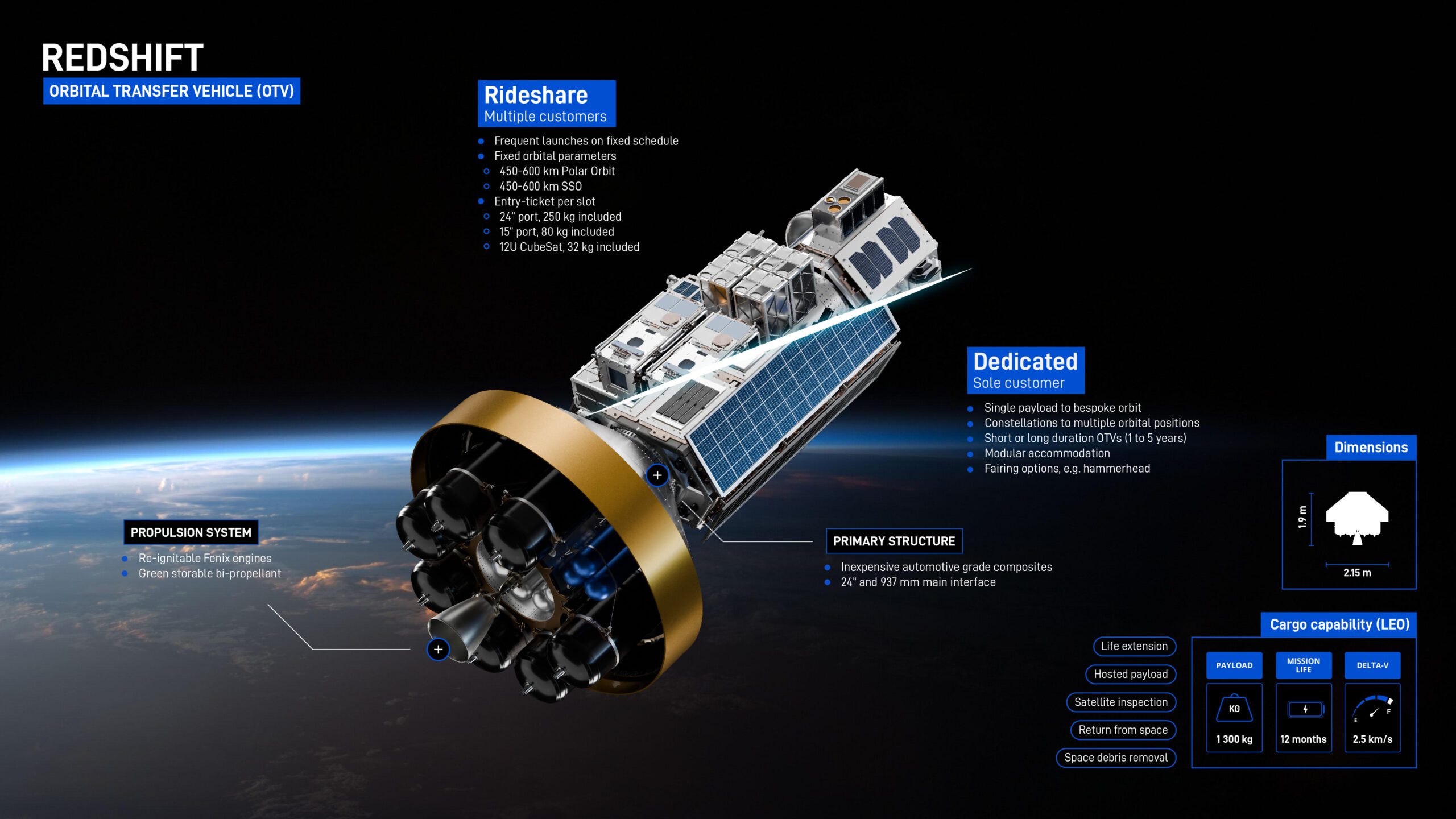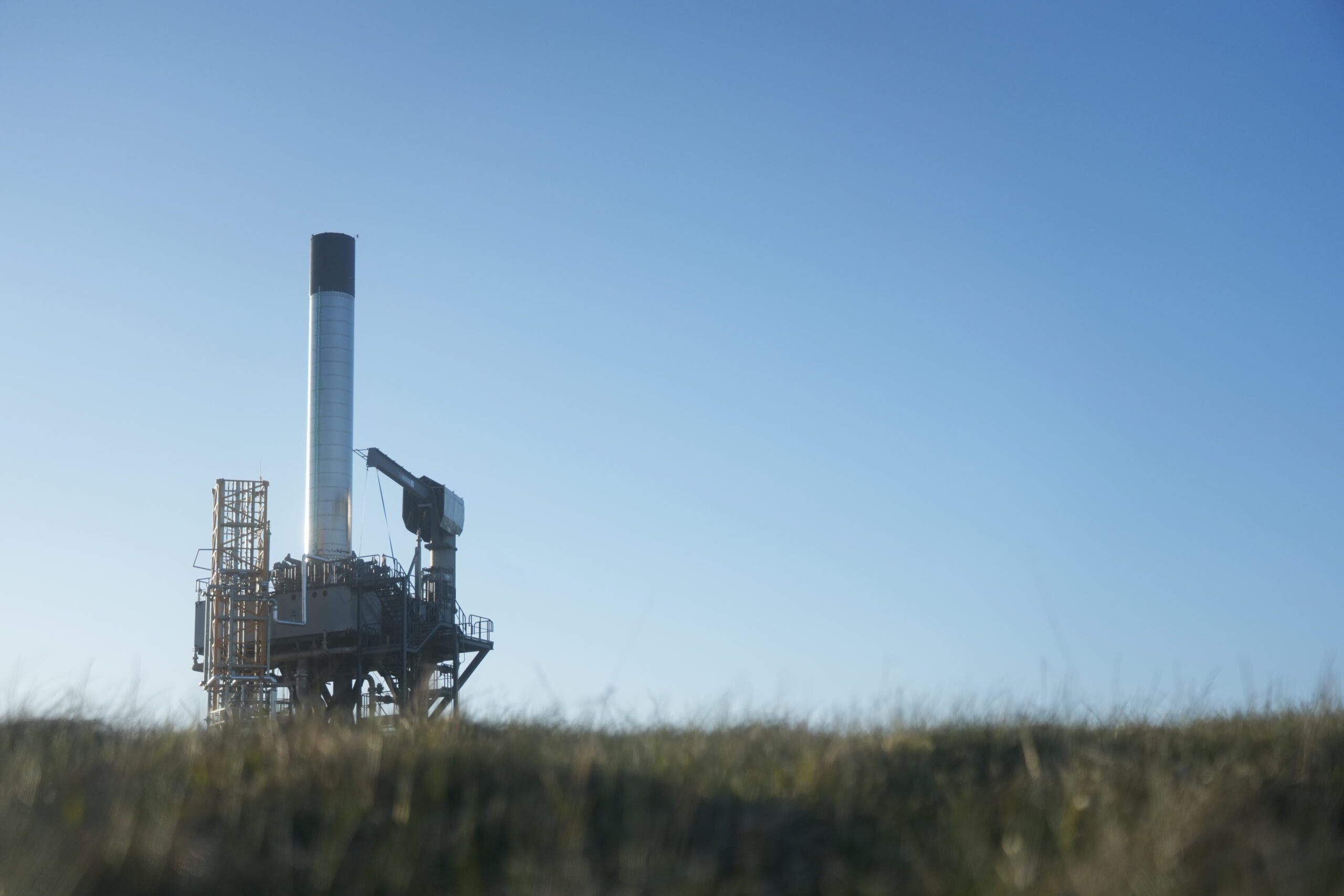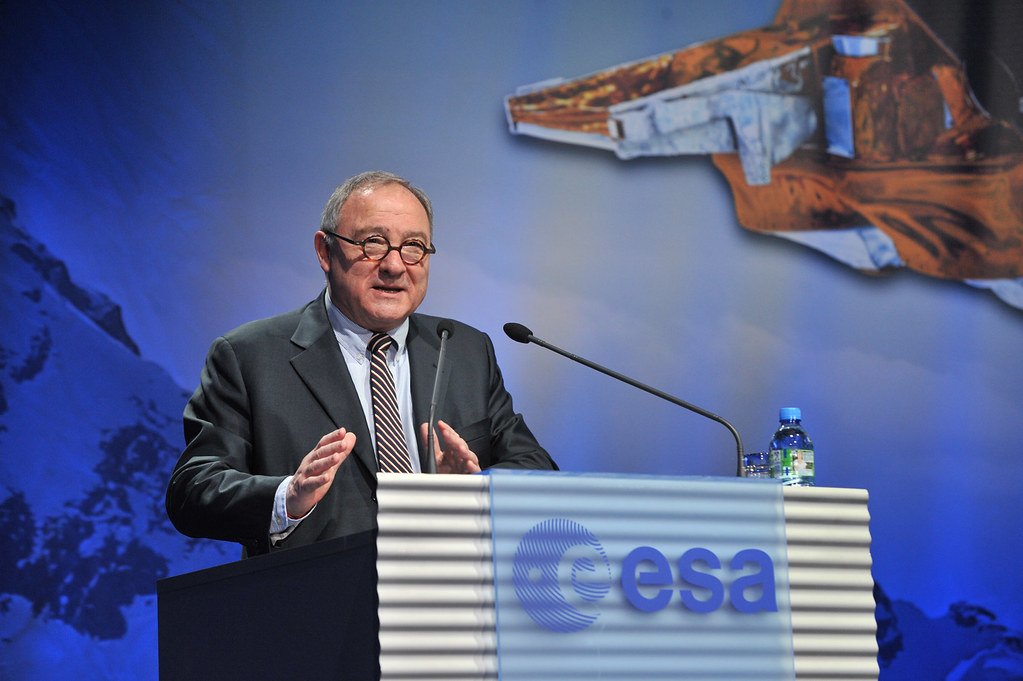We’ve got one mission at Rocket Factory Augsburg: to provide cost-effective, flexible, and frequent access to space.
At the heart of this mission is our RFA ONE launch vehicle. With three stages, innovative engine designs and a – for this rocket class – above-average payload capacity, it is built for maximum efficiency and performance.
Our previous blog post about our stage zero launch pad was a huge success so we thought we would share a deep dive look into the vehicle itself.

RFA ONE – Stage 1
The first stage of RFA ONE is designed with the sole purpose of getting the rocket off the ground and propelling our payloads through the thicker atmosphere with maximum efficiency. It’s the main workhorse of the rocket.
Stage Structure and Durability
RFA ONE’s first stage is a common-bulkhead tank design made from stainless steel, making it durable, reusable and able to withstand the intense forces of liftoff and atmospheric pressure.
Stainless steel might seem like an odd choice when the standard material for rocket structures are aerospace-grade carbon fiber or aluminum. But we don’t do things the standard way, do we? 😉
Our goal when sourcing materials was to learn what would work best in term of costs, simplicity and reusability. The solution? Beer tanks. We leverage the high-quality manufacturing skills and extensive experience of the beverage industry and order pre-welded storage tanks. Then we conduct all necessary testing and qualification in-house.
Additionally, we use a specific alloy that gains increased stiffness when filled with cryogenic fuels. This allows us to make the tank walls thinner (currently 1mm), saving valuable mass without compromising on strength. Stainless steel beer tanks are also super cheap, lending them to our low-cost approach. Furthermore, they already have the structural strength required for rocketry and are suited for serial production and reusability. What’s more, we can easily pop out any dents in minutes (literally).
Helix Engine Cluster – Why 9 Engines?
Sitting at the very bottom of stage one is a cluster of nine Helix engines that propel RFA ONE off the launch stool toward orbit.

We often get asked why we chose nine engines. This configuration was specifically chosen for several reasons.
The first is clustering increases redundancy – if one engine fails, the others can compensate. Second, using nine engines allows for greater control during ascent. We can individually throttle and gimbal each engine to steer the rocket accurately. Finally, smaller engines are way easier and quicker to produce and handle.
Our goal is to get to orbit successfully in the most efficient way – a nine-engine cluster allows us to do that.
RFA ONE Helix Engine Specifications
Our Helix engine is particularly unique. Developed in-house by our team of excellent engineers, it’s an Oxygen-Rich Staged Combustion (ORSC) engine that delivers 100kN (roughly 500,000 hp) per engine.
The staged combustion technology gives Helix up to 7% more efficiency which allows us 30% more payload and higher performance than traditional open-cycle rocket engines.
Staged combustion works by feeding the partially unburned exhaust gases from the turbopump into the main combustion chamber, burning the available fuel more completely, getting the most out of it. This also makes it more environmentally friendly.
We designed Helix and its turbopump entirely in-house for additive manufacturing, using standardized parts wherever possible, and quick and easy assembly by just a few mechanics.
In July 2022 we became the first company in the European Union to successfully develop and test a staged combustion engine in flight configuration. It also made us the third commercial company in the world to successfully test this type of engine on a large scale.
The Interstage – connecting stage 1 and stage 2
The interstage is a vital component of RFA ONE. Designed to connect stage 1 and stage 2, it is responsible for ensuring a smooth separation between the two stages. It also serves to protect the HelixVAC engine during ascent. Made from automotive-grade carbon fiber, the interstage is designed to minimize weight while maximizing structural integrity. In fact, RFA ONE is the only rocket in the world utilizing this unique stainless steel-carbon-fiber-hybrid design!
Fun fact: creating the interface between the rigid carbon fiber and stainless steel tanks was a challenge for our engineers. The tanks contract when filled with cryogenic liquid oxygen, adding complexity, but the result is a flexible interface that maintains the structure’s overall rigidity.
RFA ONE – Stage 2
Structurally, stage 2 shares the same robust design as Stage 1, but in a more compact form. Like Stage 1, it’s crafted from stainless steel tanks, applying the same cost-efficient and high-quality approach. As dictated by fundamental rocket physics, the higher you go in the rocket, the smaller the stage needs to be. That is why we have optimized Stage 2 in terms of weight, length, capacity and engine performance.

HelixVAC Engine
Alongside our standard Helix engines (Helix SL = sea level), we also developed the HelixVAC (Helix vacuum) engine for stage 2. The key differences between the Helix SL and HelixVAC engines lie in their start systems and engine nozzle.
At sea level, the Helix engine is designed to handle atmospheric pressure that pushes against the exhaust plume. To prevent flow separation and maintain exhaust jet stability, the nozzle is made smaller. However, in the vacuum of space, where there’s no atmospheric pressure, the HelixVAC engine has a much larger nozzle. This allows for targeted acceleration of exhaust gases over a longer duration, improving efficiency in space.
An interesting detail about the HelixVAC engine is that its nozzle glows in space because it isn’t actively cooled at the lower end. Despite reaching nearly the same temperature as the exhaust jet, it doesn’t melt. Woohoo, engineering!
Both engines use a spin start system that gives the turbopump an initial boost using helium before the preburner ignites. For the first stage, the launch pad’s helium system is used to save weight on stage 1. In contrast, stage two carries its own high-pressure helium bottle.

RFA ONE – Stage 3 (Redshift Orbital Transfer Vehicle)
Stage 3, also known as Redshift, is our Orbital Transfer Vehicle (OTV). When RFA ONE reaches orbit, Redshift takes over and deploys the payloads.
The primary structure is made from inexpensive automotive grade composites and it is powered by our Fenix engine – a 1,5kN, re-ignitable engine run on green, storable bi-propellant.
Payload Capacity
Our Redshift Orbital Transfer Vehicle (OTV) can carry up to 1300 kg of payload into orbit.
It can serve multiple customers at a time with rideshare capabilities or serve a single customer with a dedicated payload to a bespoke orbit. There are further configurations and customizations available – Redshift can be tailored to the needs of every customer.
You can discover more about RFA ONE’s payload capabilities in our Payload User Guide.
In-Orbit Capabilities
Redshift’s in-orbit capabilities are what really sets it apart. Going beyond just delivering multiple payloads in different orbits (altitude-and inclination-wise), it can in a not-to-far future host payloads for extended missions, assist with life extension and perform space debris removal.
These versatile capabilities make it an invaluable asset for complex and multi-faceted space missions.
The Power of Standardized Components (COTS)
One of the key innovations behind RFA ONE is our use of standardized components, or Commercial Off-The-Shelf (COTS) parts. By integrating high-quality, low-cost components from industries like automotive and oil & energy, we are able to significantly reduce both development time and production costs. This approach also ensures that our rocket benefits from the proven reliability and mass-production efficiencies of these sectors.
For example, we use stainless steel sourced from the beverage industry for our tanks, a cost-effective material that meets our high-performance needs. Or connectors, which can be found in every car harness. Or valves that usually operate welding robots. This allows us to offer a highly competitive price for launch services without compromising on quality or safety.
RFA ONE – the most unique small launcher in Europe
RFA ONE has the potential to reshape the European space industry. Built to handle the growing demands of modern space missions, RFA ONE offers customer-oriented transport services at a much lower price point. By leveraging low-cost materials like stainless steel and employing standardized components from other industries, we´ve created a flexible and cost-effective solution for access to space that can benefit any industry that wants to connect, understand and protect our Earth with data from space.














